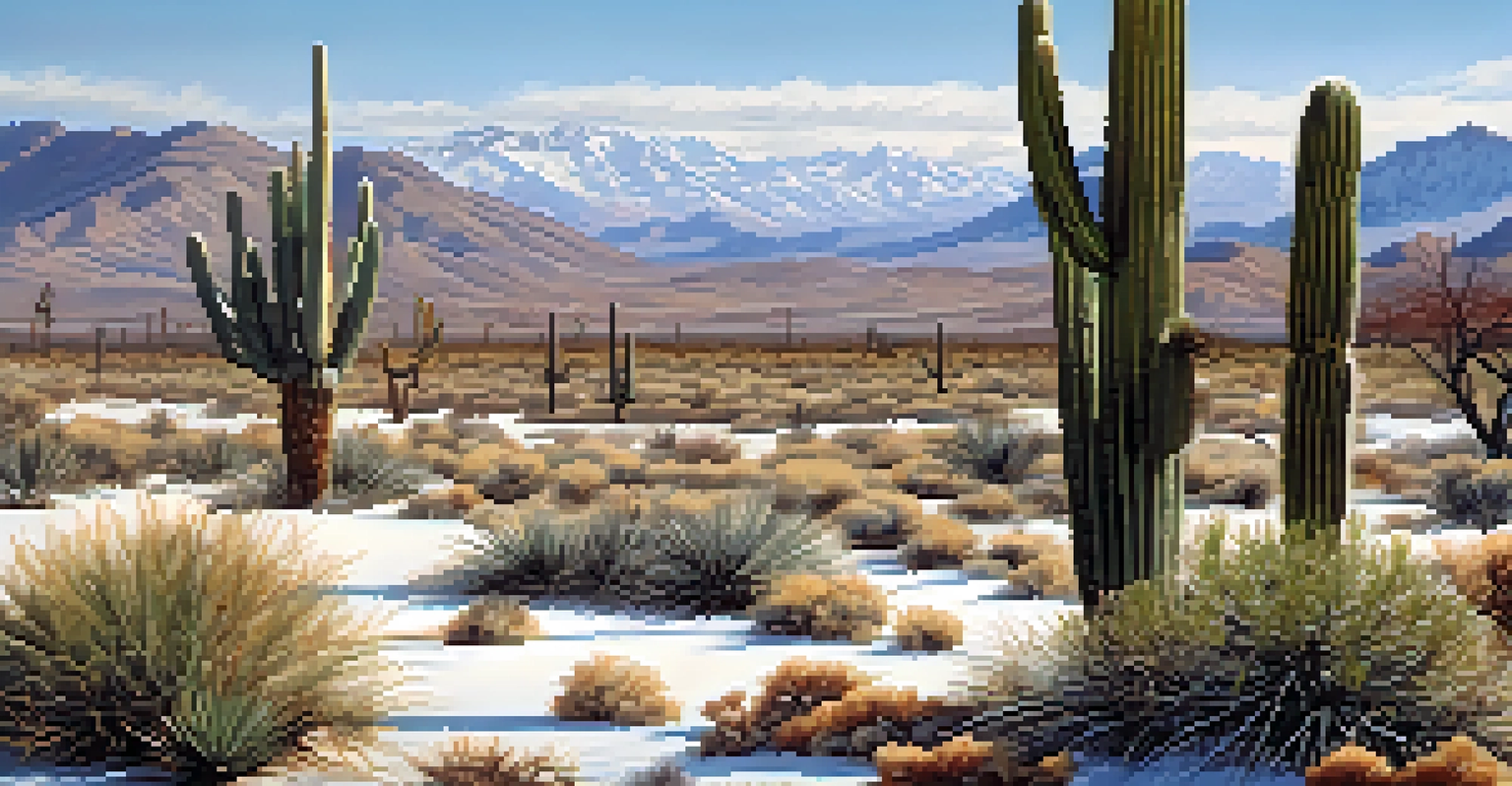Seasonal Variations in Nevada's Desert Climate and Ecology

Understanding Nevada's Desert Climate Overview
Nevada's desert climate is marked by extreme temperatures and low precipitation, creating a unique ecological landscape. The state experiences hot summers and cool winters, which directly influence the plants and animals that thrive here. This climatic diversity supports a variety of habitats, from arid deserts to mountain ranges, making Nevada an ecological treasure.
In every walk with nature one receives far more than he seeks.
In summer, temperatures can soar above 100°F, while winter nights can drop below freezing. This stark contrast creates challenges for survival, pushing organisms to adapt in remarkable ways. For example, many desert plants have developed deep root systems to tap into underground water sources, showcasing nature's resilience.
Understanding these climatic conditions helps us appreciate the delicate balance in Nevada's ecosystems. Each season brings its own set of challenges and opportunities, influencing both the flora and fauna. This interplay is crucial for maintaining the ecological integrity of the region.
Spring: A Season of Renewal in the Desert
As winter fades, spring breathes life into the desert. Temperatures gradually rise, and the once-dormant landscape bursts into a riot of colors as wildflowers bloom. This seasonal change attracts various wildlife, from migratory birds returning to nest to pollinators like bees and butterflies, drawn to the vibrant blooms.

Spring is also the time for many desert plants to reproduce. Cacti and shrubs produce seeds that disperse with the wind, ensuring the continuation of their species. This cycle of growth is essential for maintaining biodiversity in the harsh desert environment.
Diverse Seasons Shape Desert Life
Nevada's desert climate features distinct seasons that influence the behavior, reproduction, and survival strategies of both flora and fauna.
However, spring also brings a delicate balance of moisture and warmth, making it a critical time for plant and animal interactions. The interplay between species during this period highlights the interconnectedness within the desert ecosystem, where each organism plays a role in sustaining life.
Summer: Survival in the Scorching Heat
Summer transforms Nevada into a furnace, with temperatures often exceeding 100°F. During this season, many animals adapt by becoming nocturnal, foraging for food at night to avoid the harsh daytime heat. Reptiles, like lizards and snakes, bask in the sun during the cooler hours, showcasing their ability to thrive in extreme conditions.
The earth has music for those who listen.
Plant life also undergoes significant changes in summer. Many species enter a state of dormancy, conserving water and energy until the cooler months return. Others, like the resilient creosote bush, flourish, utilizing shallow root systems to absorb moisture from infrequent summer rains.
Despite the harsh conditions, summer brings unique beauty to the desert. The sunsets are particularly stunning, with hues of orange, pink, and purple painting the sky, reminding us that even in extreme environments, life finds a way to thrive.
Autumn: A Transition to Cooler Days
As autumn arrives, temperatures begin to drop, providing a much-needed relief from the summer heat. This season is marked by a gradual change in the desert landscape, as plants prepare for the winter months ahead. Leaves of certain trees may change color, adding to the beauty of the environment.
Autumn is also a time for many animals to gather resources for the coming cold. Squirrels and birds can be seen collecting seeds and nuts, storing them for winter. This behavior is essential for their survival, as food becomes scarcer in the colder months.
Spring Sparks Ecological Renewal
The arrival of spring rejuvenates the desert, prompting wildflowers to bloom and attracting wildlife, which underscores the importance of seasonal changes.
The transition into autumn brings about a sense of preparation and adaptation. The rhythms of life in the desert shift, showcasing how organisms respond to changes in their environment, ensuring their survival through the cycles of nature.
Winter: Endurance in the Cold
Winter in Nevada's desert can be surprisingly cold, with temperatures often dropping below freezing at night. Despite the chill, many desert species have adapted to survive this harsh season. Some animals hibernate, while others enter a state of torpor, slowing their metabolism to conserve energy.
Plants, too, have adapted to winter’s challenges. Many perennials go dormant, storing nutrients in their roots to survive until spring returns. This ability to withstand cold temperatures ensures that life continues in the desert, even when it seems barren.
Winter also brings occasional snowfall, which can create a stunning contrast against the arid landscape. The snow acts as a critical water source, slowly melting in spring and nourishing the ground. This cycle of life illustrates the desert's resilience and the interconnectedness of its seasonal changes.
Impact of Seasonal Changes on Desert Flora
The seasonal variations in Nevada's climate significantly influence the distribution and growth of desert flora. Each plant species has evolved specific strategies to cope with the extreme conditions of summer and winter. For instance, succulents store water in their leaves, allowing them to thrive during dry spells.
During spring, the blooming of wildflowers attracts pollinators, which play a crucial role in plant reproduction. This symbiotic relationship enhances biodiversity, as various species rely on each other for survival. The arrival of moisture during this season is vital for germination and growth.
Summer's Harshness Demands Adaptation
In the scorching summer heat, desert creatures adapt by altering their activity patterns, while plants enter dormancy to conserve resources.
As seasons change, so do the challenges for desert plants. Adaptations such as drought resistance and heat tolerance become essential for survival, demonstrating how flora responds to the dynamic desert environment. This resilience is a testament to the beauty of nature's ingenuity.
Impact of Seasonal Changes on Desert Fauna
Similarly, seasonal changes have profound effects on desert wildlife. Many animals exhibit remarkable adaptations, such as altering their behavior or diet according to the time of year. For example, some birds migrate to warmer climates during winter, while others remain and rely on stored food to survive.
Reproductive cycles are also closely tied to seasonal changes. Many species time their breeding to coincide with the availability of food and favorable weather conditions. This ensures that their offspring have the best chances of survival in a challenging environment.

Understanding these patterns in desert fauna helps us appreciate the intricate web of life in Nevada. The interplay of seasonal shifts with animal behavior highlights the delicate balance necessary for ecological sustainability in the desert.